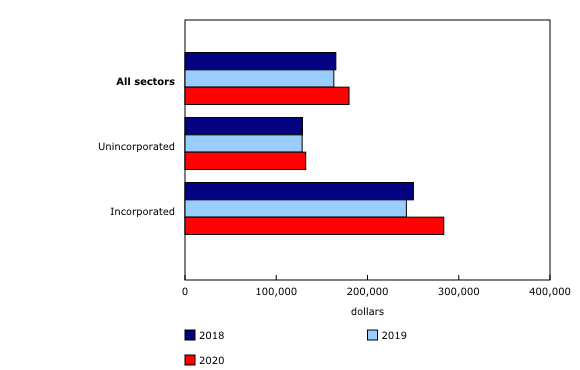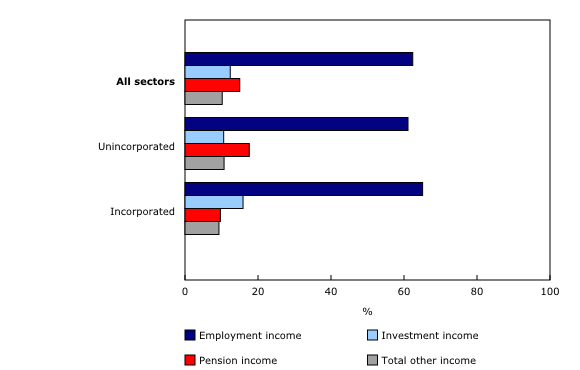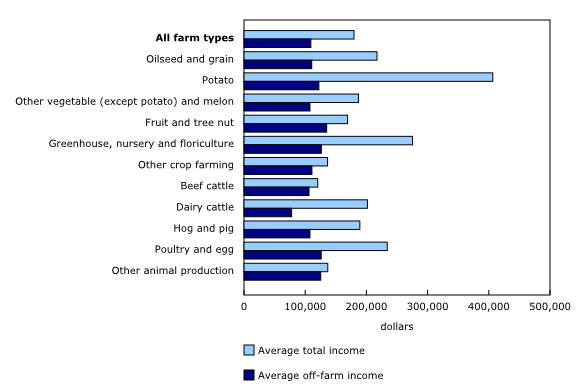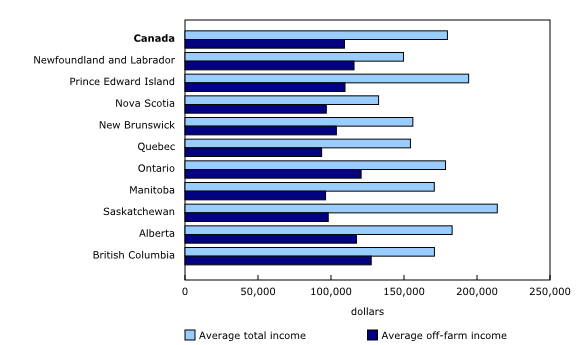Total income of farm families, 2020
Released: 2023-01-27
According to taxation records, the average total income of farm families operating a single farm in Canada was $179,724 in 2020, up by 10.2% from 2019. Canadian farmers experienced higher average net market income after low exports to China in 2019.
The average total income of farm families rose across all revenue classes, with the largest increases seen in farms with revenues of over $2 million (+20.2%) and those with revenues from $1 million to $2 million (+14.8%).
The average net operating income increased by 21.4% to $70,510. This rise was driven by a 22.4% increase in average net market income, which returned to pre-2018 levels.
The average off-farm income rose by 4.0% to $109,214 from 2019 to 2020, driven by a 27.0% increase in government social transfers and a 72.5% increase in other income. There was a similar increase across all families in Canada, likely attributable to government transfers related to the COVID-19 pandemic.
Off-farm income accounted for 60.8% of the total income of farm families in 2020, down from 64.4% in 2019.
Farm families in the incorporated sector rely more on investment income and less on pension income than those in the unincorporated sector
In 2020, the average total income of farm families increased by 3.6% to $132,928 in the unincorporated sector and by 16.9% to $283,580 in the incorporated sector. The larger growth in the incorporated sector was attributable to a 28.5% rise in average net operating income, which was much higher than the 1.4% increase in the unincorporated sector.
The average off-farm income of farm families in the unincorporated sector rose by 4.1% to $105,892 in 2020, while that of farm families in the incorporated sector increased by 3.5% to $116,586.
Farm families in the incorporated sector had more investment income than pension income, while farm families in the unincorporated sector had more pension income than investment income. Employment income remained the most significant component of off-farm income, representing about two-thirds of off-farm income in each sector.
Farm families specializing in crops have the largest growth in average total income
The average total income of farm families operating crop farms grew by 15.7% in 2020 to $201,776. This increase was driven by growth in greenhouse, nursery and floriculture production (+26.7%); other vegetable (except potato) and melon farming (+10.3%); potato farming (+14.8%); and oilseed and grain farming (+18.9%). Potato farms once again had the highest average total income, at $406,483 per farm family. The increased income for oilseed and grain farms was largely attributable to strong export demand from China (after a reduction of tariffs) and favourable weather conditions in Western Canada in 2020.
The average off-farm income of farm families grew for every farm type in 2020. Fruit and tree nut farms had the highest average off-farm income, at $135,078 per farm family. They were followed by farm families specializing in greenhouse, nursery and floriculture production; poultry and egg production; and other animal production.
In 2020, farm families specializing in potato farming; dairy cattle and milk production; and greenhouse, nursery and floriculture production derived most of their income from farming activities. Meanwhile, off-farm income was the most significant portion of total income for farms specializing in other animal production, beef cattle ranching and farming, other crop farming, and fruit and tree nut farming.
Prairie farm families earn the highest average total income in the country
The average total income increased in every province. Nationally, farm families in Saskatchewan earned the highest average total income, at $213,896 per farm family. This was followed by farm families in Prince Edward Island and Alberta. The increased income was driven by higher average net market income of farm families specializing in oilseed and grain production.
The average off-farm income of farm families also grew in every province in 2020. That same year, farm families in British Columbia posted the highest average off-farm income nationally, at $127,518. Ontario farm families were in second place, followed by those in Alberta, down slightly from one year earlier. Farm families in British Columbia had more non-farm self-employment income compared with the rest of Canada.
Note to readers
The estimates cover farm families involved in a single farm that is either unincorporated with total operating revenues of $10,000 or more or incorporated with total operating revenues of $25,000 or more.
Starting with the 2020 reference year, a farm is defined as an operation that produces at least one agricultural product and will report revenue or expenses for that agricultural production to the Canada Revenue Agency, as opposed to the previous definition based on the intention to sell agricultural commodities. Data users should use caution when comparing data from the previous years.
Note that not all farm family income earned from a farming operation is net operating income. Income reported as wages and salaries may have come from the farm. However, the investment income has been adjusted to exclude the actual number of dividends received by families from taxable Canadian farming corporations.
For statistical purposes, farm families who hold an interest in a partnership that has filed a T5013 Partnership Information Return are included in the incorporated sector, starting with reference year 2017. Prior to 2017, all farm families who were members of a partnership were included in the unincorporated sector.
Farm families may include more than one operator. Within an Agriculture Taxation Data Program framework, an operator is a person who reports revenue on their individual tax form as a result of a financial stake of a farm operation. The financial stake may be direct in the case of an unincorporated farm (generally T1) or indirect through shares for an incorporated farm (generally T2).
In this release, average always refers to average per farm family. Table 32-10-0213-01 also presents averages per farm family reporting.
For more information on farm family income components, see "Description of farm family income components."
For more information on agriculture and food, visit the Agriculture and food statistics portal.
Contact information
For more information, or to enquire about the concepts, methods or data quality of this release, contact us (toll-free 1-800-263-1136; 514-283-8300; infostats@statcan.gc.ca) or Media Relations (statcan.mediahotline-ligneinfomedias.statcan@statcan.gc.ca).
- Date modified:




